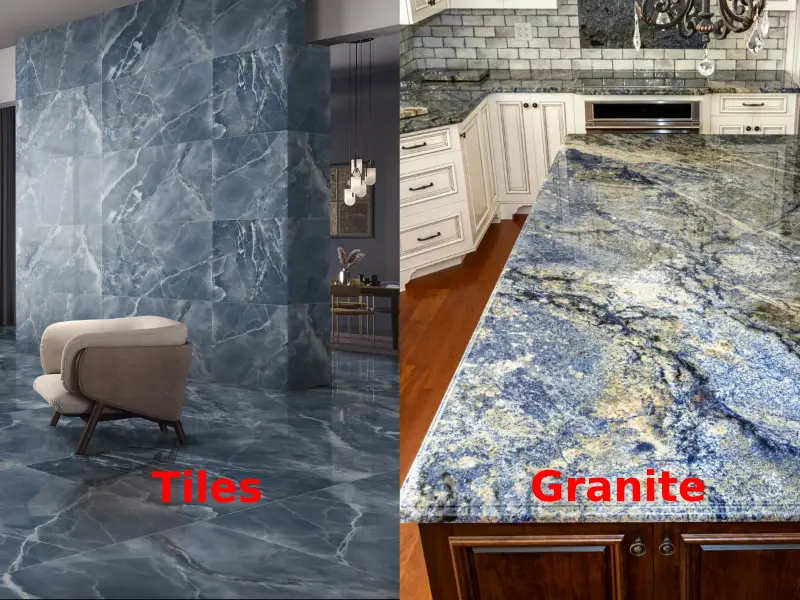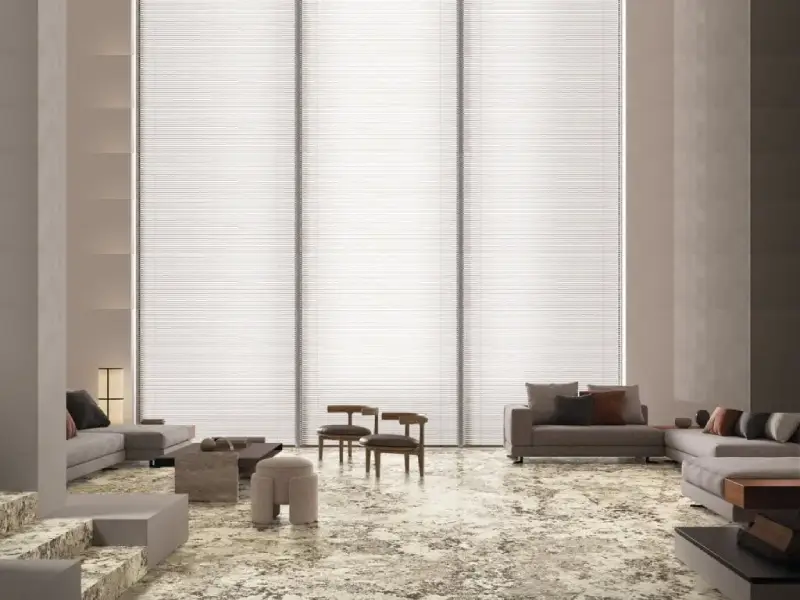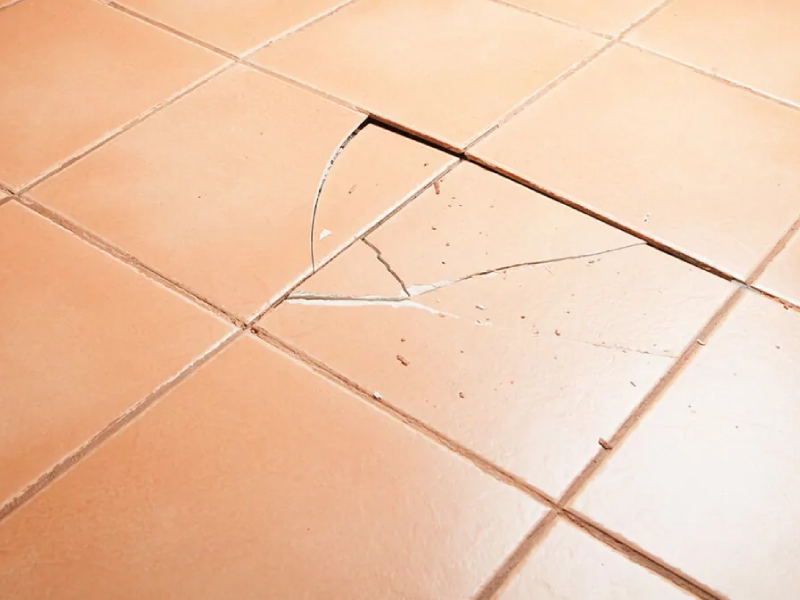Choosing the right flooring for your home or commercial space is like picking the perfect foundation for your dreams. It’s not just about aesthetics; it’s about creating a space that feels right and stands the test of time. When it comes to deciding between granite and tile, the stakes are high, not only financially emotionally but also practically. This comprehensive guide on “Granite vs Tiles” will help you navigate through the pros and cons, ensuring you make a choice that you’ll love for years to come.
Understanding the differences between granite and tile is crucial in making this significant decision. Each option comes with its own set of benefits, costs, and maintenance requirements. By exploring the specifics of granite flooring alongside the popular tile options, including ceramic and vitrified tiles, you’ll gain the knowledge needed to choose the best fit for your needs. Whether you’re looking for unmatched durability, timeless beauty, or a balance between cost and aesthetic appeal, knowing what each material offers will empower you to make an informed choice. This guide will walk you through everything you need to know, ensuring your decision is one you’ll be satisfied with for years to come.

Granite vs Tiles: A Comparative Overview
When it comes to choosing flooring for your home or commercial space, granite and tiles are two of the most popular options available. Each has its own unique characteristics and benefits, making the decision between them an important one.
Granite and Tiles: What’s the Difference?
Granite is a natural stone formed from volcanic rock and is known for its durability and unique patterns. Tiles, on the other hand, can be made from a variety of materials, including ceramic, porcelain, and vitrified substances. The key differences lie in their composition, appearance, and performance.
Before we move ahead, let’s take a moment to understand what ceramic and vitrified tiles are, and what sets them apart from granite.
Granite vs Vitrified Tiles: Which is Better?
Vitrified tiles are made from a mixture of clay and minerals that are fired at high temperatures. They are known for their water resistance and durability. While granite offers a luxurious appearance with natural veining, vitrified tiles are a more cost-effective option with consistent coloring and patterns. Vitrified tiles can be a better choice if you’re looking for affordability and ease of maintenance, but granite excels in creating a high-end look.
Granite vs Ceramic Tiles: Comparing Cost and Performance
Ceramic tiles are made from clay and are often glazed to add color and texture. They are generally more affordable than granite and come in a variety of styles. Ceramic tiles are suitable for many areas but may not match granite’s durability or luxury appeal. Granite, though more expensive, provides superior strength and a timeless aesthetic.
Ceramic Vs Vitrified Tiles
Vitrified tiles are made by blending clay with silica, quartz, and feldspar, then baking at high temperatures to create a glass-like, non-porous finish that is highly durable and stain-resistant. Ceramic tiles, on the other hand, are made from natural clay and baked at lower temperatures, making them slightly more porous and less durable than vitrified tiles. However, ceramic tiles offer a wider variety of designs and are generally more affordable, making them a versatile option for many spaces.
With the advent of homogeneous and full body tiles, the comparison between granite and tiles has become even more pronounced. These advanced tile types have intensified the debate by introducing new factors to consider.
.webp)
Full Body Tiles vs Granite
Full body tiles, also known as through-body tiles, are made from the same material throughout, which ensures that any wear or chipping will not affect the overall look. They are highly durable and suitable for high-traffic areas.
Homogeneous Tiles vs Granite
Homogeneous tiles are made from a uniform mixture of materials, ensuring consistent quality and durability throughout the tile. They are known for their strength and are often used in commercial settings.
What is the Difference between Homopgeneous and Full Body Tiles?
While the terms are often used interchangeably, “homogeneous” specifically refers to the uniform mixture of materials, whereas “full body” emphasizes that the design or color runs through the entire thickness of the tile. In practice, many full body tiles are also homogeneous, but the terminology might vary based on the manufacturer and product specifications.
Granite
Granite tiles offer natural beauty with unique patterns and colors. They provide a luxurious finish and high durability but can be more expensive compared to homogeneous tiles and full body tiles. Choosing between homogeneous or full body tiles and granite depends on whether you prefer natural stone or a more uniform, cost-effective option.
Comparision of Granite Vs. Ceramic Tile Vs. Vitrified Tiles
| Factors | Granite | Ceramic Tile | Vitrified Tiles |
|---|---|---|---|
| Material | Natural | Manufactured | Manufactured |
| Composition | Quartz, feldspar, and mica | Clay, sand and water | Clay, silica, quartz and feldspar |
| Stain Resistance | High | Moderate | High |
| Scratch Resistance | Very High | Moderate | High |
| Porosity | Non Porous after proper sealing, Low Porosity | High Porosity | Low porosity |
| Chipping Resistance | Highly Resistant to impact | Prone to chipping, especially edge and corners | Less Prone to chipping but may chip due to impact |
| Impact Resistance | High Resistant and can withstand heavy loads and impact | High risk of cracking under impact or if installed over uneven surface | Less likely to crack to moderate impact but high risk under heavy impact |
| Thickness | Typically ranges from 20-30 mm, can be customised furhter | Ranges from 5-10 MM | Ranges between 10-12 mm. The full-body tiles generally come in 15 mm thickness and more |
| Price | Expensive due to handling and weight | Affordable | Moderate, full body and homogeneous tiles can be pricier than some of granite |
| Suitablity | – Suitable for floors, walls, countertops and facades. – Ideal for both indoor and outdoor application | – Suitable for walls and floors – Only Indoors | – Suitable for floors & walls – Can be used outdoors |
This table summarizes the key differences between granite, ceramic tile, and vitrified tiles based on various factors
Granite Flooring vs. Tiles: What Are the Pros and Cons?
Choosing the right flooring material involves several factors, including material choice, variety, appearance, luxury, budget, installation time, and safety. Here’s a detailed comparison between granite and tiles to help you make an informed decision:
Material Choice
Granite: If you prioritize natural, organic materials and have an eco-friendly building, granite is an excellent choice. As a natural stone, granite is environmentally friendly and free from synthetic chemicals. Its natural origin makes it a suitable option for those seeking sustainability and authenticity in their flooring.
Tiles: Tiles are factory-made and involve the use of some chemicals in their production. While they offer a range of design options and are durable, they may not align with an eco-friendly lifestyle as closely as natural materials like granite.
Also READ | Selecting the Perfect Granite Finish Types for Your Construction Project

Variety and Appearance
Granite: Granite provides a unique, one-of-a-kind look due to its natural formation. Each granite slab features distinct patterns and colors, ensuring that no two installations are exactly alike. Its natural variations add to its luxurious and premium appeal.
Tiles: Tiles come in a vast array of designs, finishes, and textures, including options that mimic the look of natural materials like granite and marble. They offer a wide variety of styles but may have repeating patterns.
Luxury vs. Natural Look
Granite: Granite is often considered the epitome of luxury in flooring. Its premium appearance and natural beauty create an elegant and high-end look that enhances the value of your property. The natural stone’s unique veining and texture are hard to replicate with manufactured materials.
Tiles: While vitrified tiles can mimic the look of natural stones and offer a sophisticated appearance, they may not fully capture the depth and uniqueness of genuine granite. They provide a visually appealing and natural look, but the luxury factor and “feel” may not be as pronounced.
Cracking and Chipping
- Granite: Granite is highly durable and resistant to cracking, though it can still occur under heavy impact or due to underlying structural issues. Proper installation and regular sealing help minimize the risk of cracks. Chipping is less common with granite, but high-impact accidents can cause damage, particularly along edges and corners. Overall, granite’s toughness makes it less prone to everyday wear and tear compared to many other materials.
- Tiles: Tiles are also designed to be durable but are more susceptible to cracking if subjected to moderate impact or if there are even small problems with the subfloor. Cracks can appear over time, especially in areas with poor installation. Chipping is a more frequent issue with tiles, particularly along edges or from direct impact.

Also READ | Is Granite Porous? or Non-porous or How Porous Is it?
Installation Time
Granite: The installation of granite can be time-consuming and complex due to its weight and the need for precise cutting and fitting. Professional installation is often required, which can extend the project timeline.
Tiles: Tiles are typically easier and faster to install compared to granite. They are lighter and come in various sizes, making the installation process more straightforward and quicker.
Safety
Granite: Polished granite can be slippery when wet, posing a safety risk in areas prone to moisture. Non-slip finishes or treatments like leathered granite, honed granite, lapotra granite, sandblasted texture, can help mitigate this issue.
Tiles: Similar to granite, polished vitrified tiles can also become slippery when wet. For areas like bathrooms, balconies, and outdoor spaces, opting for anti-skid tiles can enhance safety and prevent accidents.
Also READ | How to Enhance Safety with Anti-Skid Granite Stairs: Effective Methods and FAQs
No comparison is complete without considering pricing, as it plays a crucial role in the decision-making process. While initial cost is important, it’s equally vital to consider the long-term financial implications of your choice.
Also READ | Granite Price Per Square Foot – Understanding Factors


Tiles vs. Granite: Price Comparison
When choosing between tiles and granite, understanding the cost implications is crucial. Here’s a detailed comparison to help you make an informed decision:
Tiles
-
- Affordability: Tiles are generally budget-friendly. Even specialized types, such as anti-skid tiles used for bathrooms and kitchens, remain affordable.
- Production: Tiles are mass-produced and come in various sizes, which can be tailored to your needs if the order size is substantial.
- Cost Range: Tiles typically start at around INR 40- 60 per square foot. The price can increase depending on the tile’s type, thickness, and finish. But, premium options like full body and homogeneous tiles tend to be in line with granite price or more in some instances.
Granite
-
- Cost: Granite is often more expensive due to its natural origin and the complex quarrying process. Its price reflects its premium status and unique aesthetic appeal.
- Installation: The installation of granite can be costly because it is heavy and often requires additional support such as sub-flooring or reinforced backing.
- Cost Range: High-quality granite can start at over ₹100 per square foot. Despite its higher initial cost, granite can be more cost-effective in the long run. Its exceptional durability and timeless appeal mean that it often outlasts other materials and requires less frequent replacement or maintenance.
Aslo READ | Why Natural Stone Is Cheaper In The Long Run Compared To Engineered Options
As tiles have grown in popularity and manufacturers have invested heavily in evolving their processes trying to match the quality and durablity of natural stone, their prices have been on the rise. On the flip side, granite prices have been dropping thanks to better quarrying and processing techniques. Even though granite and tiles might cost about the same per square foot now or smaller difference, granite can be pricier to install. But remember, when you choose granite, you’re investing in a natural material with a classic look and lasting durability. While tiles might be cheaper initially, granite offers timeless value and a touch of elegance that can make your space truly stand out.
.webp)
Conclusion
When it comes to choosing the right flooring for your space, both granite and tiles have their own appeal. Granite offers a stunning, timeless look that’s hard to beat. Its natural beauty and durability make it a long-lasting investment, often paying off in the long run despite the higher initial cost. If you’re after elegance and a material that stands the test of time, granite is definitely worth considering.
On the other hand, tiles come with their own set of benefits. They are generally more budget-friendly and come in a huge variety of designs. Tiles can be a practical choice, especially if you need something that’s easy to install and maintain. Specialized options like anti-skid tiles can also be a smart choice for wet areas, adding extra safety.
In the end, the choice between granite and tiles really comes down to your personal needs and preferences. Granite is a great option for those looking for luxury and durability, while tiles offer versatility and affordability. Both choices have their strengths, so you can’t go wrong with either—it just depends on what fits best with your vision for your space.
Even after reading through our guide, if you still have questions or need personalized advice, feel free to reach out to us! Contact us, and we’ll be happy to help you with all your granite needs.









![Latest GST on Granite Slabs & Blocks [2025 Chart + HSN + Price Examples]](https://stonegalleria.in/admin/images/blog/latest-gst-on granite.webp)







